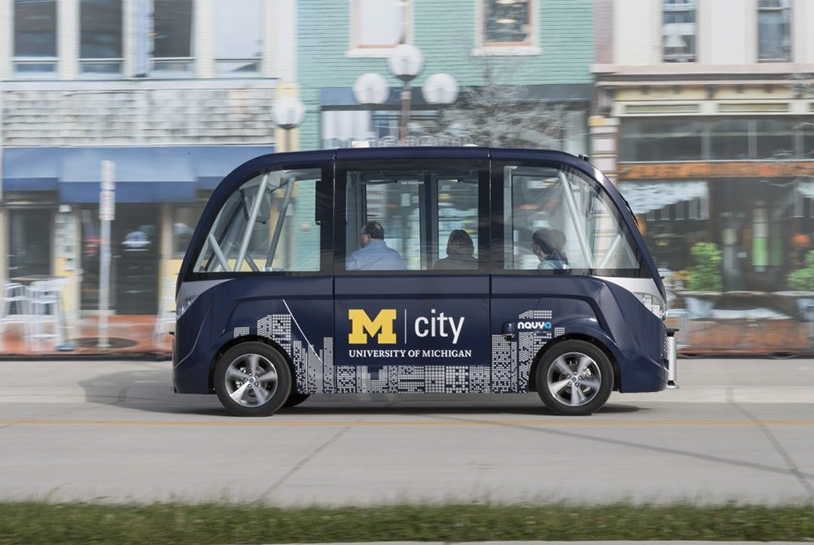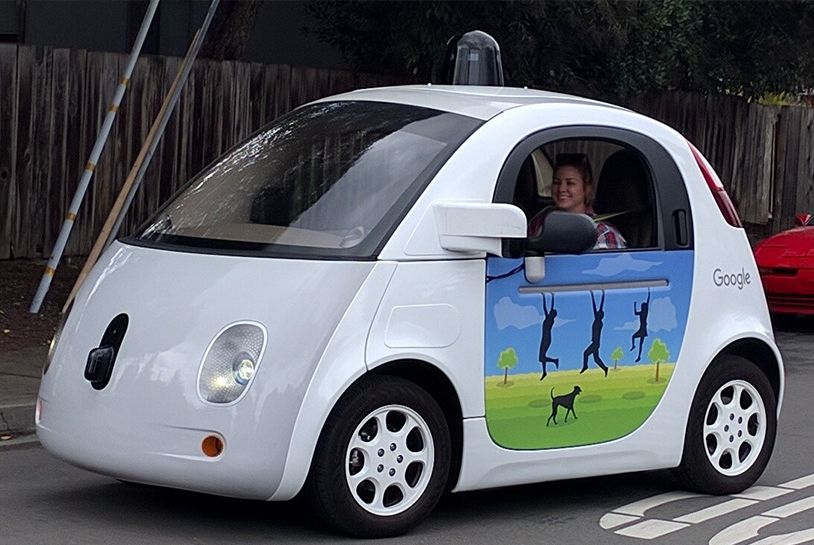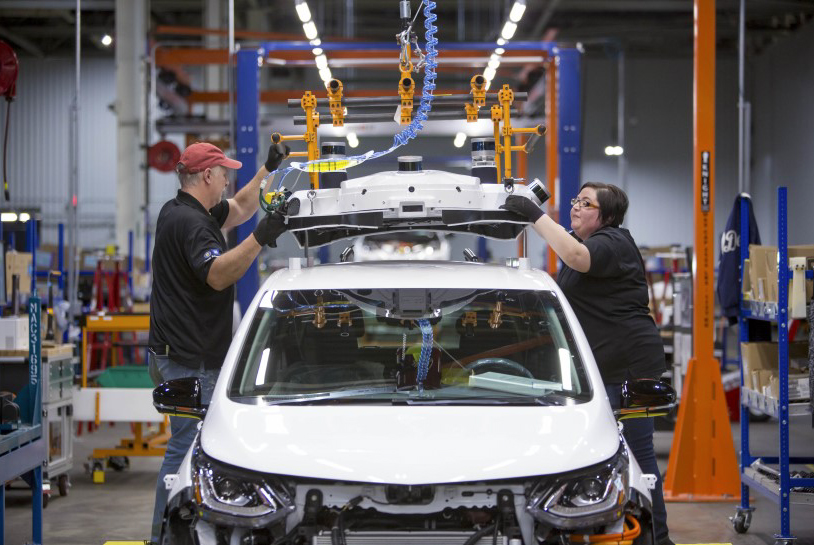Community Impacts of Transforming Personal Mobility
The first autonomous vehicle (AV) was demonstrated in Japan in 1977. With innovations in battery life and communications technology, our society is about to embark on a transportation revolution. Soon AVs will begin to replace some of the existing inventory of vehicles, which totals one billion on Earth and approximately 238 million vehicles in the United States. The introduction of autonomous vehicles will significantly impact how our society transports goods and people, and it may have a transformative impact on cities, rural areas, and everything in between.
- University of Michigan AV test vehicle—Source: mcity.umich.edu
- Google Vehicle—Source: Wikimedia Commons
- Chevrolet Bolt EV autonomous test vehicles being assembled at General Motors Orion Assembly in Orion Township, MI—Source: GM
What are autonomous vehicles? The National Highway Traffic Safety Administration outlines five levels of vehicle automation based on how active the driver must be in controlling the vehicle:
- Level 0: Vehicles equipped with no automated features, requiring the driver to be in complete control of the vehicle.
- Level 1: Vehicles equipped with one or more primary automated features such as cruise control.
- Level 2: Vehicles equipped with two or more primary automated features, such as cruise control and lane-keeping, that work together to relieve the driver from controlling those functions.
- Level 3: Vehicles equipped with features that allow the driver to relinquish control of the vehicle’s safety-critical functions depending on traffic and environmental conditions. The driver is expected to take over control of the vehicle if needed.
- Level 4: Fully autonomous vehicles that monitor roadway conditions and perform safety-critical tasks throughout the duration of the trip with or without a driver in the vehicle.
Today, many cars on the market are at Level 1, and technology continues to develop rapidly. Yet, in addition to the technological challenges associated with the development of AVs, other issues to overcome include consumer confidence and demand, data security, protection against cyberattacks, regulations and liability laws. According to researchers at the University of Michigan, the car companies and most industry experts predict AV market penetration and full adoption of NHTSA Level 4 AVs around 2030. This gives communities some time to consider the impact of AVs.
Many people will find that autonomous vehicles relieve the pressures of driving, allow them to multi-task, and offer door-to-door service while the car self-parks. But for an aging population, autonomous vehicles may offer much more than that – they potentially present opportunities for people to retain their independence by providing additional mobility choices. In areas without reliable transit (or any transit), the freedom of personal mobility that AVs offer people of all ages and abilities could be transformational.
Other potential benefits include more efficient use of existing roadways due to platooning of vehicles coordinated with traffic signals, reduced vehicle crash rates, reduced lane widths, more efficient on-time delivery for manufacturers, and reduced demand for retail inventory storage in high-priced retail floor space. Additionally, reduced parking demand will create new development opportunities or open space.
With all these potential benefits, AVs will bring challenges, too. Without the hassles of commuting, AVs may promote sprawl by making it easy to live in rural areas and commute to cities. The impact to road congestion may not be alleviated by AV if commuters continue to choose single occupancy vehicles for peak hour travel rather than transit or ride sharing. Additionally, determining liability for crashes or malfunctions in the AV system is very complex and includes balancing a complex web of data providers, information infrastructure, vehicles, remaining motorists and non-motorized users, and others.
Planning & Zoning News from Our Communities:
Development is booming in Farmington Hills, ranging from upgraded gas stations to a unique automotive research center. A zoning health check up is underway in Sylvan Lake. Comprehensive Plans are wrapping up in DeWitt Township and the City of Brighton. Capital Improvement Plans are in the review process in the cities of St. Johns and Lathrup Village.

Source: Brian Solis (Altimeter)
Community Considerations: How can communities begin planning for AVs?
Passenger Staging Areas and Flexible Curb Zones. These are already a reality in some locations, including airports and downtown areas, as private car services such as Uber and Lyft see usage rates grow in every market. Communities will need to identify and implement strategic staging areas for efficiency.
Location of AV Charging and Maintenance Facilities. Some experts forecast that most AVs will leave cities (and other dense locations) at the end of the day and travel to remote sites where they will be recharged and maintained, returning to cities in the early morning as demand increases. Communities may need to consider where to locate these remote sites.
Adaptable Design and Regulatory Standards. It makes sense to foster an infrastructure and regulatory framework that is adaptable. Communities should explore parking and site standards that accommodate changing mobility and parking needs. If communities approve adaptable standards, ordinance amendments will not be required for every incremental change in technology.
Rebalancing the Right-of-Way. Increases in vehicular safety could lead to the narrowing of travel lanes and reduction of roadway infrastructure. Further, it could open the door to add an extensive bike lane network at a modest cost because lanes would be created via restriping existing roads, not roadway widening. Communities should consider these impacts when creating complete streets plans.
Giffels Webster, working for your community!
Giffels Webster will help you identify and leverage your unique resources to improve the assets and attractiveness of your community. Whether its increased walkability and connectivity, better streetscape design and parking, more natural settings and gathering places or other changes to enrich your city, we will work in partnership with you how to attract and retain businesses and residents.
As your municipal partner, we also review submitted site plans, conduct inspections, maintain records, prepare master plans, and lead the planning, bidding, and construction administration process for capital improvement projects. For more information, call us at 866.271.9663.


